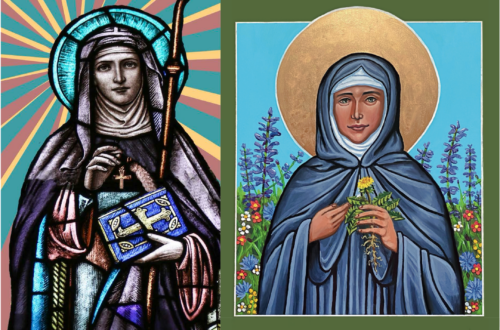Keeping the Faith
The Keepers (2017) is a seven-part original documentary by Netflix investigating links between the 50-year-old unsolved murder of a well-loved Maryland nun and systemic corruption by establishment figures—including clergy and police—involving the alleged rape of teenagers in the Roman Catholic school where she taught.
This summary does not do the production justice.
The Keepers is many things, including spellbinding storytelling. It is a true-crime whodunnit and a portrait of devotion (amateur sleuths keeping faith with a beloved teacher, marriages formed from real love and journalists doggedly pursuing the truth over decades). It is an exploration of what might nowadays be described as male privilege, but which feminists orginally termed “the patrirachy”; a dissection of the signs, symptoms and sequalae of post-traumatic stress disorder (PTSD) triggered by abuse and that abuse’s attendant gaslighting of victims; a reminder of how the commitment to faith of ordinary believers, even in the face of the most egregious crimes by religion’s self-appointed apostles, can be sustaining and transcendent. And it is a meditation on the nature of evil.
What The Keepers is not is anti-Catholic.
* * *
The radical, swinging ’60s did not reach Catonsville, MD, or its adjacent western suburbs of Baltimore. The town land was briefly famous for the “Catonsville Nine,” Catholic antiwar activists who burned their draft cards in protest of the Vietnam War. You will not hear about them in The Keepers. Nor will you hear the Beatles on The Keepers soundtrack, and you will listen in vain for reference to Woodstock. The civil rights movements of the day—the march on Washington, the symbolic bra burnings—did not impinge on this apparently tranquil, white working-class community where Sister Catherine Cesnik lived at the time of her disappearance.
Rather, the decade presented here resembles the ’50s fever dream so popular in current political discourse. This would be Eisenhower’s America, if only Eisenhower had been Roman Catholic.
Church looms as a living presence in the lives of Cantonville’s residents. Mass on Sunday, religious schooling and conservative social values, especially concerning gender. Women’s official place is in the kitchen or the convent. Marriage is early and children are often. One of The Keepers’ witnesses, for example, describes how her staunchly Roman Catholic father dismissed her academic ambitions, not withstanding a stellar performance at school. So she married young, soon after becoming a mother. Decades later, however, she retrieved these original dreams and is now a lawyer representing, among others, African Americans involved in the Black Lives Matter movement.
* * *
Viewers are reminded that Maryland, one of the most densely populated American states, was (disputably) Roman Catholic from the time settlers first engaged with the Piscataway. During the very bloody 17th-century European religious wars, the colony was intended as a refuge for followers of the old faith. Signaling this purpose, Maryland was provocatively named for Henrietta Maria, later widow of the decapitated king of England, Charles I. These Stuart monarchs were both staunch Catholics, the last of their religious persuasion. Since 1701, English law has explicitly prevented Roman Catholics from recovering the English throne.
Roman Catholic preeminence in Maryland was solidified by the work of John Carroll, archbishop of Maryland and founder of Georgetown University, who makes a cameo appearance in The Keepers. Let it be understood: Maryland—and Baltimore—is a special (Catholic) case.
* * *
In this presumed Eden where no black people were permitted to intrude, girls attending Roman Catholic school were fair game for the sexual disorders of powerful white men. These men included the school’s chaplain and his assistant who, in common with their fellow predators, sought out the more psychologically vulnerable to exploit personally and to pimp to others while they watched, all on church-managed school premises. Gynecological visits were also arranged, with these priests in attendance. “He [the chaplain] must love you very much to stay in the room for this exam,” teenagers, their feet in stirrups, were told.
That girls’ vulnerabilities were exposed through the confessional adds a further layer of horror. One of the witnesses recounts how she went to confession hoping to be relieved of the guilt she carried from her uncle’s abuse—only to find herself making private visits to the chaplain’s office for what he described as “counseling” or “gynecological consultations.” In reality, these sessions offered a master class in what is now known as slut shaming. Calling their victims “whores” and “harlots,” these men insisted on having these girls swallow the “juice of the Holy Spirit.” Predictably, they and their families were threatened if any of the victims talked. (Not an idle threat, as it turned out.)
That girls’ vulnerabilities were exposed through the confessional adds a further layer of horror.
* * *
The National Institute of Mental Health (NIMH) defines post-traumatic stress disorder as “a [acute or chronic] disorder that develops in some people who have experienced a shocking, scary or dangerous event.” Further, NIMH claims, “Fear triggers many split-second changes in the body to help defend against danger or to avoid it. People who have PTSD may feel stressed or frightened even when they are not in [immediate] danger.” In addition to what NIMH describes as “re-experiencing symptoms,” such as flashbacks, PTSD patients may also manifest “avoidance symptoms,” such as “staying away from places, events, or objects that are reminders of the traumatic experience” and “avoiding thoughts or feelings related to the traumatic event.”
This last symptom is key to establishing the validity of sexual abuse claims. Classic avoidance techniques, often uniformly described by unrelated individuals, include dissociation at the time of the trauma (“I was watching myself from the ceiling”) and repressed memories thereafter. “The heightened awareness of child sexual abuse that developed in the 1980s also brought with it the controversial topic of recovered memory,” write the authors of TheFreeDictionary’s online legal dictionary. “Some mental health therapists contended that children repress memories of abuse so completely that years later they have no memory of it. […] Others in the medical community, however, held deep reservations about the idea of repressed memory and the therapy techniques that purported to recover them.”
Quite simply, are survivor stories of abuse—stories that emerge after memories become so physically or psychologically painful as to be no longer capable of continued burial—to be believed when finally heard? The answer is ideological: Do I identify with the putative victims or the alleged perpetrators? Or, put another way, do I stand with the powerful or the powerless?
Which is where the charismatic Sister Cathy enters the story.
Do I identify with the putative victims or the alleged perpetrators? Or, put another way, do I stand with the powerful or the powerless?
* * *
In many ways a product of Vatican II, Catherine Cesnik was an idealistic young nun committed to her work as a teacher of girls and a custodian of their welfare at school. Although she formed a soulful attachment to an equally young priest, she refused his offer of laicization and marriage, believing completely in her vocation and the value of her work. (He is one of the keepers of the documentary’s title—a keeper of the flame.)
Sister Cathy stood with the powerless. Tragically, she also held a naïve belief in the power of her role. Reassuring one timid victim, who had been so ritually shamed as to be literally incapable of speech, Sister Cathy promised to have the school rehabilitated by the end of summer break. Instead, she was murdered.
The powerful, locally and in Baltimore, were less than enthusiastic about solving Sister Cathy’s murder, even though she was a popular figure and a uniformed member of the church, and police procedures at the time are open to question. As Peter Crawley noted this year in the Irish Times, “a closed-ranks Archdiocese moved [the chaplain] around various parishes and institutions (at one point to Ireland), the police conducted a guarded, perhaps compromised investigation and a bewildering state’s attorney avoided prosecution. ‘The cover-up itself is the cancer inside Baltimore,’ says one journalist, with good reason.”
Decades later, choosing to disbelieve the powerless, church and civil authorities proved similarly hostile to Jane Doe and Jane Roe’s efforts to bring their chief perpetrator to justice. The Janes are named and interviewed on camera in The Keepers, and a great deal is learned about their lives in the intervening decades. Their courage is peerless, and the loving support of husbands and families hits a much-needed redemptive note.
* * *
The Keepers was nominated for a Primetime Emmy as Outstanding Documentary, losing (respectably) to David Attenborough’s Planet Earth II. For the most part, it is skillfully told, and the protagonists become as familiar as household members. Viewers feel a sisterhood with the Janes and share in the sleuths’ discoveries as if in real time, the puzzle pieces multiplying through social media outreach. The sense of horror is heightened too, and the cliffhanger style with which these intertwined stories is presented propels the story forward.
As Julia Raeside of the Guardian noted: “At the end of each episode, a new fact is dropped into the narrative like a boulder into a lake and the backwash forms the next episode. You would say it was a cheap trick if [director Ryan] White hadn’t put this breathtaking work together with such care.” But whither this momentum and to what purpose? There is no resolution, nor any call to action. The murder is unsolved; the primary abusers are cold in their graves. Perhaps the enduring value here lies with the sense of community redefined by the keepers themselves.
They persist.




